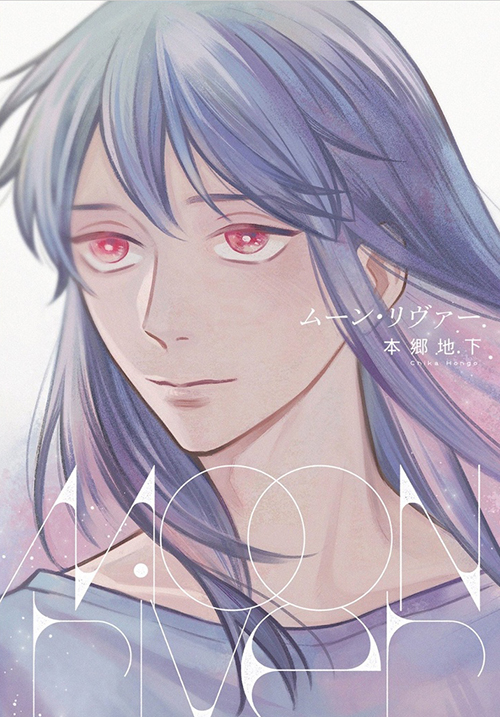 Impulse-buying a book, especially a comic, solely based on its cover isn’t all that unusual. In fact, there’s an expression in the Japanese language that describes just that: jakettogai or, in its short form, jakegai. But buying a book mainly because of its title admittedly might be an even rarer thing. Moon River… You read the title and instantly hear the same-titled song in your head as an air of bittersweet nostalgia brings back memories of the lovely Audrey Hepburn in Breakfast at Tiffany‘s… A closer look at the cover illustration of HongÅ Chika’s one-volume manga Moon River might give you a hint that the story told on its pages will be a little different than the one about the materialistic and naïve Holly Golightly in the aforementioned classic Hollywood movie. The eyes of Kurea (クレア, possible romanizations are Clair, Claire or Clare), one of the protagonists of the manga, are glowing ominously red, suggesting he might be something else than a mere mortal. And yes, this is the story of a vampire and his relationship with his human companion of 20 years, the second protagonist Roka.
Impulse-buying a book, especially a comic, solely based on its cover isn’t all that unusual. In fact, there’s an expression in the Japanese language that describes just that: jakettogai or, in its short form, jakegai. But buying a book mainly because of its title admittedly might be an even rarer thing. Moon River… You read the title and instantly hear the same-titled song in your head as an air of bittersweet nostalgia brings back memories of the lovely Audrey Hepburn in Breakfast at Tiffany‘s… A closer look at the cover illustration of HongÅ Chika’s one-volume manga Moon River might give you a hint that the story told on its pages will be a little different than the one about the materialistic and naïve Holly Golightly in the aforementioned classic Hollywood movie. The eyes of Kurea (クレア, possible romanizations are Clair, Claire or Clare), one of the protagonists of the manga, are glowing ominously red, suggesting he might be something else than a mere mortal. And yes, this is the story of a vampire and his relationship with his human companion of 20 years, the second protagonist Roka.
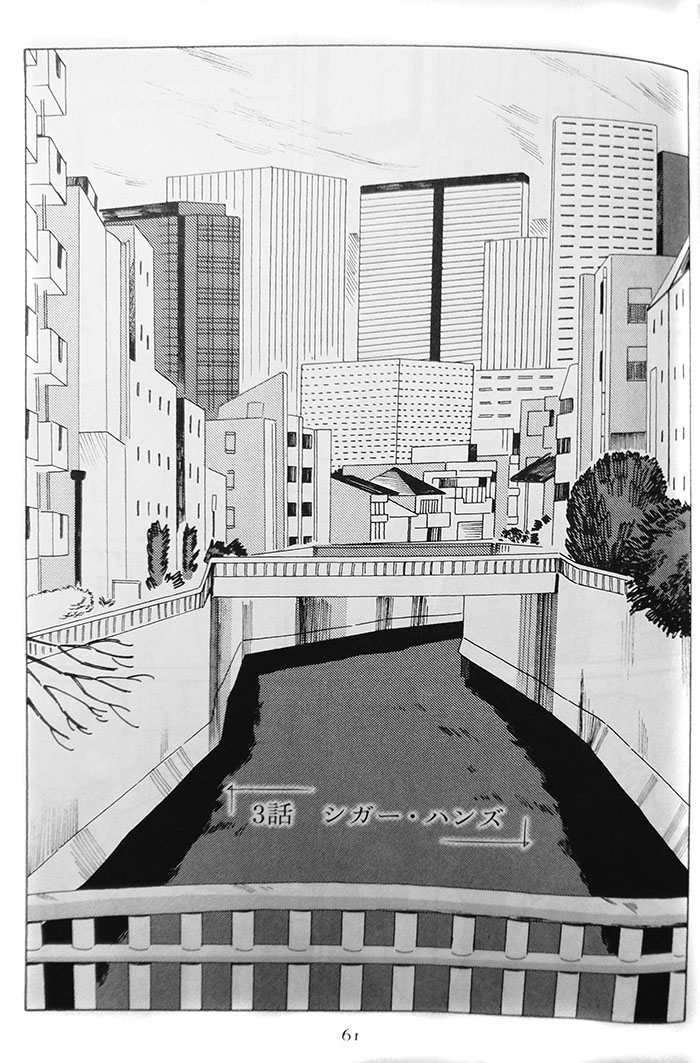 Utsumi Roka is a young man who works as an editor in the picture book department of a publishing house. His endeavours to become a published picture book writer himself haven’t been successful yet but he doesn’t want to let go of that dream. He’s living in a small apartment by himself when one Halloween night, he is more or less forced to take in an old acquaintance: an American called Kurea whom he met back when Roka was a small lonely Japanese boy after his father’s work-related transfer to the USA. It doesn’t take long until we learn that Kurea is a special kind of vampire via a genetic mutation which makes him an outsider among his dominantly “pure-blood”, “turned by being bitten or having had blood contact” kind. He has “lived†a long long time and has to take special types of medicine to help him live a seemingly normal live, unharmed by the sun and contaminated water. But those pills come with side effects and Kurea is still sick once a month.
Utsumi Roka is a young man who works as an editor in the picture book department of a publishing house. His endeavours to become a published picture book writer himself haven’t been successful yet but he doesn’t want to let go of that dream. He’s living in a small apartment by himself when one Halloween night, he is more or less forced to take in an old acquaintance: an American called Kurea whom he met back when Roka was a small lonely Japanese boy after his father’s work-related transfer to the USA. It doesn’t take long until we learn that Kurea is a special kind of vampire via a genetic mutation which makes him an outsider among his dominantly “pure-blood”, “turned by being bitten or having had blood contact” kind. He has “lived†a long long time and has to take special types of medicine to help him live a seemingly normal live, unharmed by the sun and contaminated water. But those pills come with side effects and Kurea is still sick once a month.
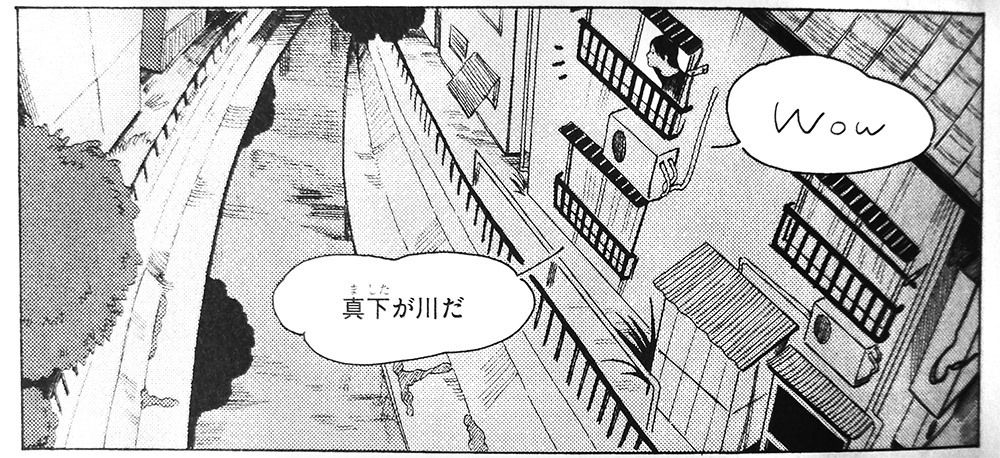
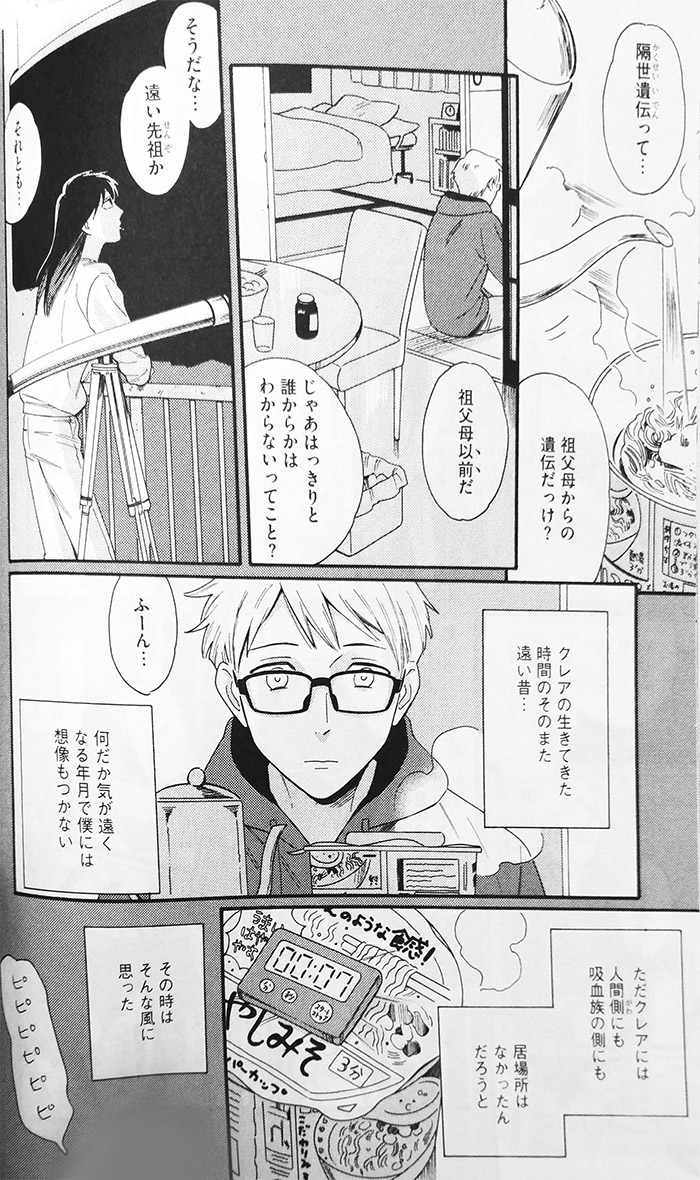 Quiet scenes of the two men’s everyday lives are presented to us: Roka working hard at the office, the shy man getting closer to one of his co-workers, giving him career advice; his difficulties of living together with Kurea in the apartment as the open river flows gently right behind the house. Roka putting up a telescope, watching the stars. Kurea resting after taking his pills. Roka’s obsession with Japanese sweets and desserts that makes him go to different parts of Tokyo. Kurea’s constant smoking by the window. It’s almost as if they’ve achieved a kind of timelessness for themselves through their routines, a fake sense of eternal repetition.
Quiet scenes of the two men’s everyday lives are presented to us: Roka working hard at the office, the shy man getting closer to one of his co-workers, giving him career advice; his difficulties of living together with Kurea in the apartment as the open river flows gently right behind the house. Roka putting up a telescope, watching the stars. Kurea resting after taking his pills. Roka’s obsession with Japanese sweets and desserts that makes him go to different parts of Tokyo. Kurea’s constant smoking by the window. It’s almost as if they’ve achieved a kind of timelessness for themselves through their routines, a fake sense of eternal repetition.
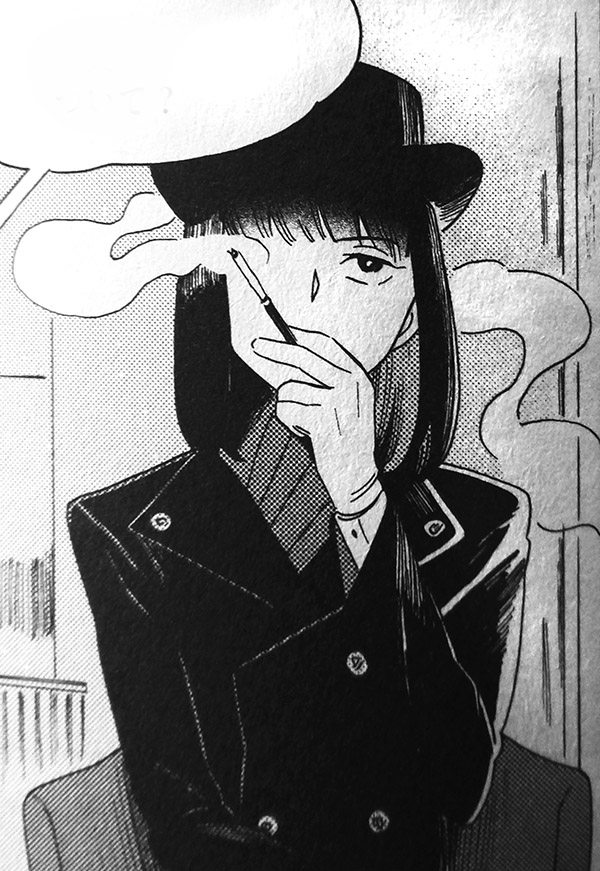
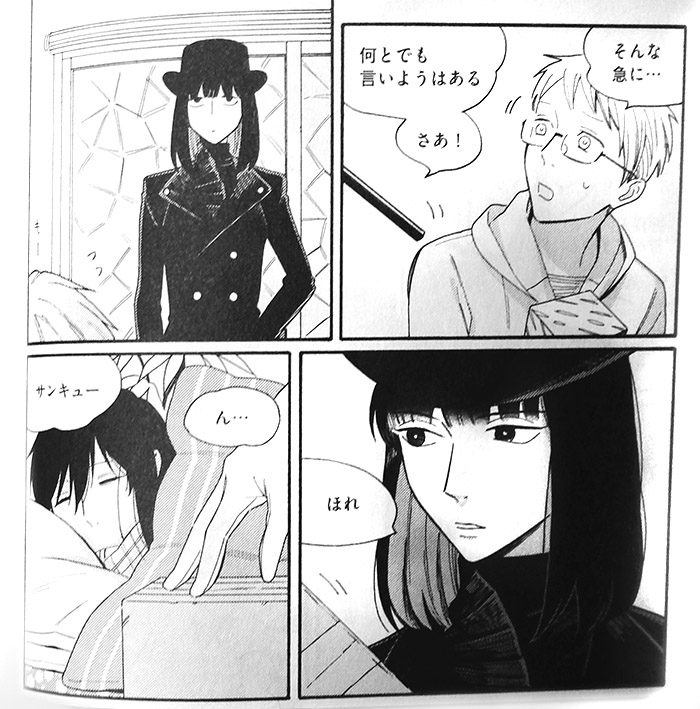 But then a third person breaks that fragile balance of their humble, almost ordinary lives: Lucian, a man in an elegant old-fashioned suit and hat, with a fixation with quality Japanese household appliances (don’t ask!), like Kurea a heavy smoker and like Kurea a vampire, but of the “pure-blood” kind in his case. Lucian has taken on the role of Kurea’s guardian, checking in on him and his health – and making sure that Kurea is keeping his life with the very human Roka on the downlow because other, more powerful vampires don’t like it much if their kind mixes with mortals. Short flashbacks and nothing but hinted words serve as reminders of the extraordinariness of Kurea’s existence and tell of the tragic past of Kurea’s and Roka’s life in America, their feelings for each other and the measures Roka was willing to take to become a vampire himself, until he tragically failed. What fate awaits them when one of them is destined to live forever, unlike the other one who is faced with his own mortality and the desperation of not being able to stay with his companion until eternity?
But then a third person breaks that fragile balance of their humble, almost ordinary lives: Lucian, a man in an elegant old-fashioned suit and hat, with a fixation with quality Japanese household appliances (don’t ask!), like Kurea a heavy smoker and like Kurea a vampire, but of the “pure-blood” kind in his case. Lucian has taken on the role of Kurea’s guardian, checking in on him and his health – and making sure that Kurea is keeping his life with the very human Roka on the downlow because other, more powerful vampires don’t like it much if their kind mixes with mortals. Short flashbacks and nothing but hinted words serve as reminders of the extraordinariness of Kurea’s existence and tell of the tragic past of Kurea’s and Roka’s life in America, their feelings for each other and the measures Roka was willing to take to become a vampire himself, until he tragically failed. What fate awaits them when one of them is destined to live forever, unlike the other one who is faced with his own mortality and the desperation of not being able to stay with his companion until eternity?
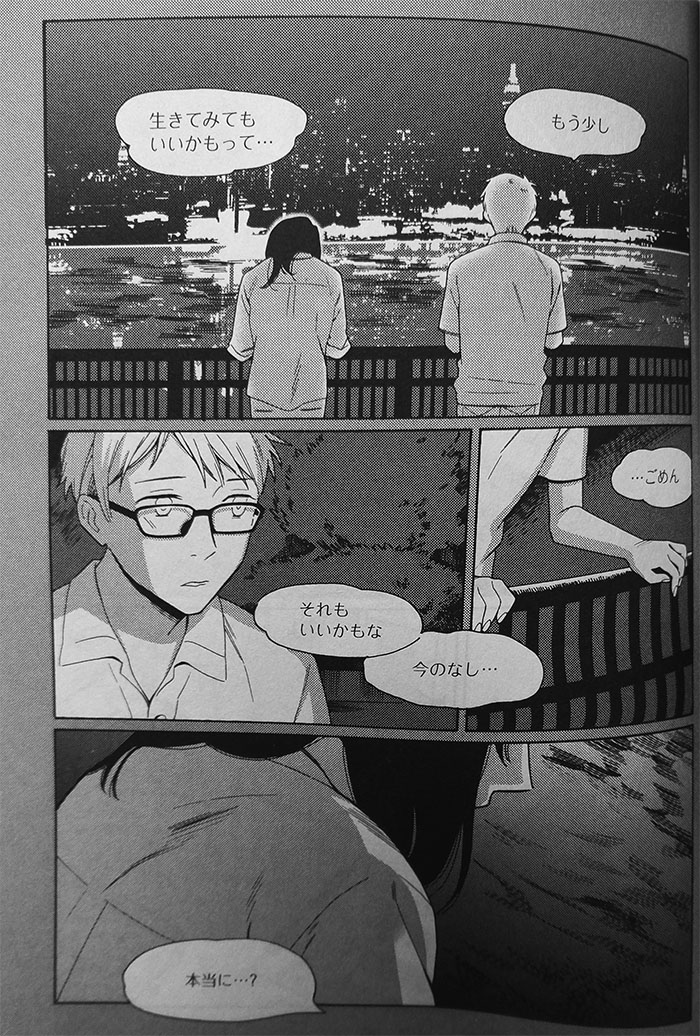
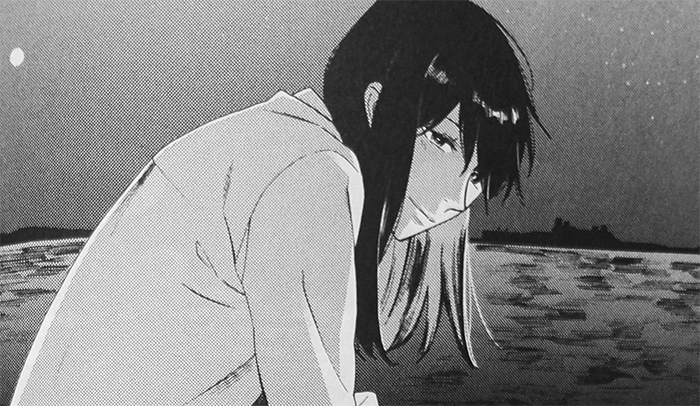 Avoiding so many stereotypes established by previous works of the genre and delivering interesting twists and unusual details, Moon River can be called an almost realistic vampire story that can definitely be enjoyed by people who usually don’t read vampire stories. And it’s a Boys’ Love story, even for people who aren’t that much into BL – but also (and naturally), for BL fans. HongÅ Chika can be considered a BL author; her only other comic volume published to date was published under the BExBOY Comics Deluxe label, for example. But since Moon River originally ran in Wings magazine (Shinshokan), the nature of Roka’s and Kurea’s relationship is only hinted at and never gets explicit or graphic. This story relies on few words and explanations in general which means a lot of reading between the lines is required from the reader. Emotional outbursts are almost nonexistent here. It is more concerned with everyday life, one’s daily habits and being present in the moment, with hints of the past and – in the end – of the future. Almost until the end, it preserves its quiet atmosphere that keeps feelings under the blanket of routine and the seemingly ordinary.
Avoiding so many stereotypes established by previous works of the genre and delivering interesting twists and unusual details, Moon River can be called an almost realistic vampire story that can definitely be enjoyed by people who usually don’t read vampire stories. And it’s a Boys’ Love story, even for people who aren’t that much into BL – but also (and naturally), for BL fans. HongÅ Chika can be considered a BL author; her only other comic volume published to date was published under the BExBOY Comics Deluxe label, for example. But since Moon River originally ran in Wings magazine (Shinshokan), the nature of Roka’s and Kurea’s relationship is only hinted at and never gets explicit or graphic. This story relies on few words and explanations in general which means a lot of reading between the lines is required from the reader. Emotional outbursts are almost nonexistent here. It is more concerned with everyday life, one’s daily habits and being present in the moment, with hints of the past and – in the end – of the future. Almost until the end, it preserves its quiet atmosphere that keeps feelings under the blanket of routine and the seemingly ordinary.
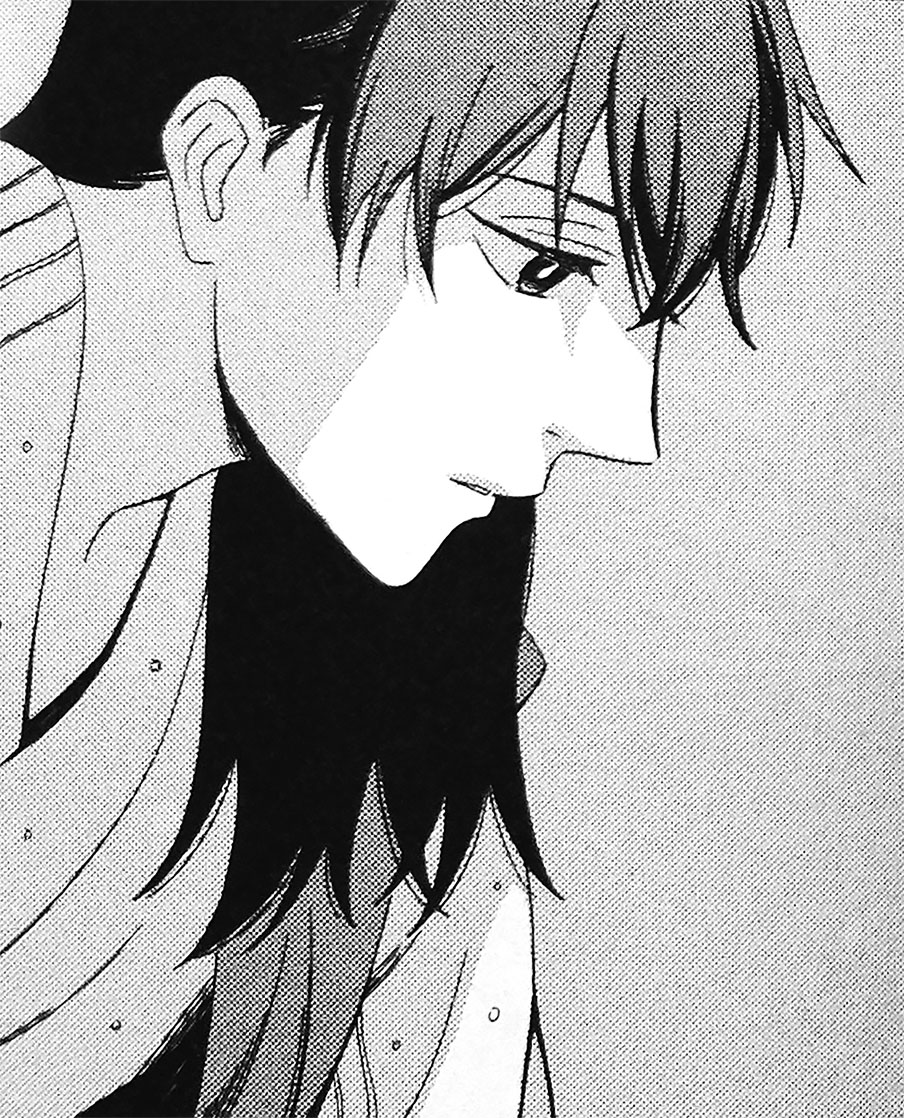 And Moon River is presented with a lot of restraint on more than one level, not just the narrative one. One of its most striking elements is the setting, the location of Roka’s apartment in a house with the river flowing openly behind it. (The author has identified the river as the Kandagawa and the location as Yayoi-chou in Nakano-ku, Tokyo, in one of her tweets.) The depiction of the quiet neighbourhood and the small, sometimes stifling apartment really draw you in as a comfortable place you want to be in with the characters. Angular architecture is paralleled by clean page layouts and panels dominated by rectangular, bold lines. The backgrounds are not too ornately detailed which serves and increases the low-key atmosphere of the entire work. The character designs are somehow reminiscent of the 1990s Wings style, with more emphasis on realism than on classic shÅjo manga-style super pretty characters with sparkles in their eyes or roses decorating their hair. We do get a lot of interesting perspectives and a variety of facial expressions despite the simplicity. Emotions are expressed very well graphically in mostly subtle ways that mirror the characters’ inner restraint.
And Moon River is presented with a lot of restraint on more than one level, not just the narrative one. One of its most striking elements is the setting, the location of Roka’s apartment in a house with the river flowing openly behind it. (The author has identified the river as the Kandagawa and the location as Yayoi-chou in Nakano-ku, Tokyo, in one of her tweets.) The depiction of the quiet neighbourhood and the small, sometimes stifling apartment really draw you in as a comfortable place you want to be in with the characters. Angular architecture is paralleled by clean page layouts and panels dominated by rectangular, bold lines. The backgrounds are not too ornately detailed which serves and increases the low-key atmosphere of the entire work. The character designs are somehow reminiscent of the 1990s Wings style, with more emphasis on realism than on classic shÅjo manga-style super pretty characters with sparkles in their eyes or roses decorating their hair. We do get a lot of interesting perspectives and a variety of facial expressions despite the simplicity. Emotions are expressed very well graphically in mostly subtle ways that mirror the characters’ inner restraint.
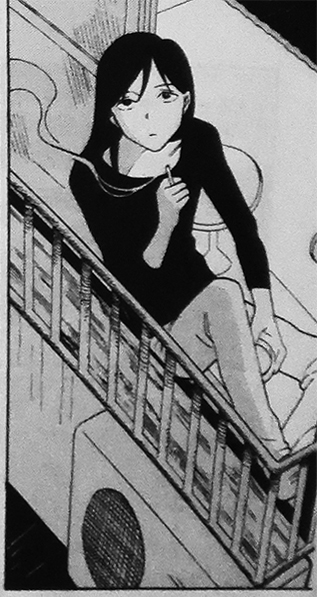 Even with all that holding back of deeper emotions, Moon River isn’t a heavy, depressing read. It manages to keep a balance between the sadder, sometimes shocking moments and calming scenes of daily routines and also scenes of comic relief. As quietly meandering as the story may seem throughout the first part of the book, it is unstoppably speeding toward its climax, set in motion by Roka and Kurea leaving the apartment by the riverside when they travel to Northern Japan. That journey gives a nod to Miyazawa Kenji and the snowy landscape of Northern Japan which dissolves the more rigid page designs from earlier on as the story races towards its dramatic ending. Yet until the last page, Moon River stays beautiful and calm.
Even with all that holding back of deeper emotions, Moon River isn’t a heavy, depressing read. It manages to keep a balance between the sadder, sometimes shocking moments and calming scenes of daily routines and also scenes of comic relief. As quietly meandering as the story may seem throughout the first part of the book, it is unstoppably speeding toward its climax, set in motion by Roka and Kurea leaving the apartment by the riverside when they travel to Northern Japan. That journey gives a nod to Miyazawa Kenji and the snowy landscape of Northern Japan which dissolves the more rigid page designs from earlier on as the story races towards its dramatic ending. Yet until the last page, Moon River stays beautiful and calm.
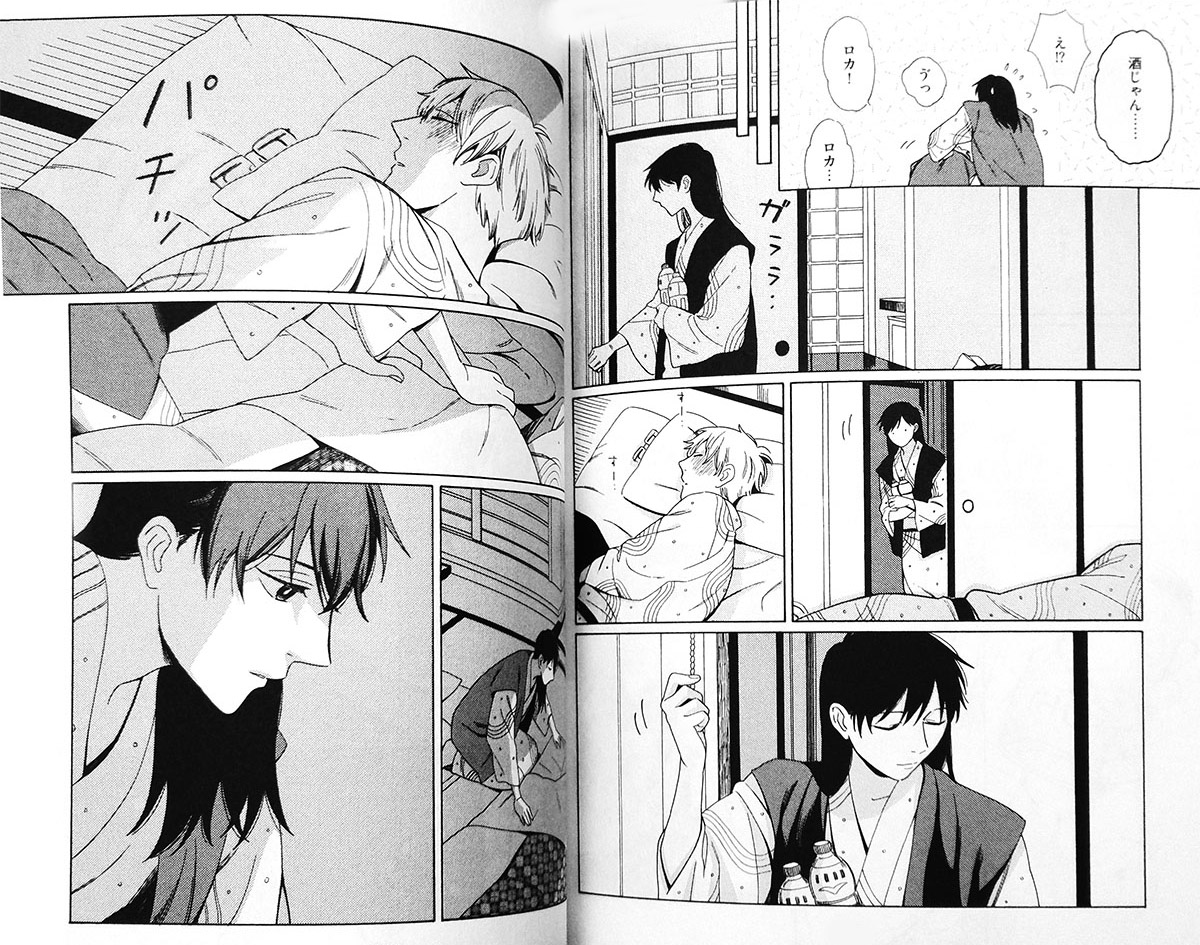
Maybe every shÅjo/BL work that’s telling a vampire story with more or less evident homoerotic elements must be prepared for comparisons with Hagio Moto’s classic Poe no Ichizoku. Moon River seems almost like its antithesis with its emphasis on everyday life, a small cast of characters that aren’t too complex (which by no means is meant as a bad thing here), foregoing the lavishly decorated, the grand and the epic. But it does hold at its core a theme central to the whole vampire sub-genre: the lingering within the stream of time, as humans die while vampires endure and have to witness the humans’ passing away. An important idea here is that of a piece of art, more specifically a picture book, but also literature and culture in general that preserve the essence of a human being long after its death. Through Roka’s & Kurea’s story, HongÅ Chika tells her readers about the human desire to leave something behind that endures longer than our own life, that is of use to other people longer than our stay on earth. And here it’s being creative, more specifically creating something beautiful through its meaningfulness to others, that emerges as the essence of being human and that allows us to be connected with other minds, transcending time and space. Ultimately, it is a story about death and how to transcend it – the essence of the lyrics of Moon River, the song, and Moon River, the beautiful, simple but touching manga volume by HongÅ Chika.
Title: Moon River (also stylized as moon river)
Author: HongŠChika (本郷地下)
Volumes: 1 (complete; 2016)
ISBN: 978-4-403-62227-4
Format: B6
Prize: 590 Yen (excluding tax)
Magazine: Gekkan Wings
Label: Wings Comics
Publisher: Shinshokan
Additional information: Visit its info page on the Shinshokan website and click on the blue tameshiyomi button for a preview of the first 32 pages of the comic.
And now have a cookie for reading all the way down here: HongŠChika herself posted the original illustration used for the final cover artwork through her Twitter account ↓
ã‚«ãƒãƒ¼åŽŸç”»ã§ã™ðŸŽƒãƒ©ãƒ•ã¯ã„ãã¤ã‹æã„ãŸã‚“ã§ã™ãŒã€æœ€åˆã«æã„ãŸã“ã‚Œã—ã‹ãªã„ãªã‚(å‹æ‰‹ã«)ã¨ã„ã†ã‚‚ã®ã«ãƒã‚«ã‚’足ã—ãŸã€ã¨ã„ã†æ„Ÿã˜ã§ã—ãŸã€‚デザインã¯ç¤¾å“¡ã®æ–¹ãŒã‚„ã£ã¦ä¸‹ã•ã£ãŸã®ã§ã™ã€‚ã‚ã‚ŠãŒã¨ã†ã”ã–ã„ã¾ã—ãŸ( ◜◡◠) pic.twitter.com/3iGkz0Sojm
— 本郷地下 (@chika_london) 4 November 2016

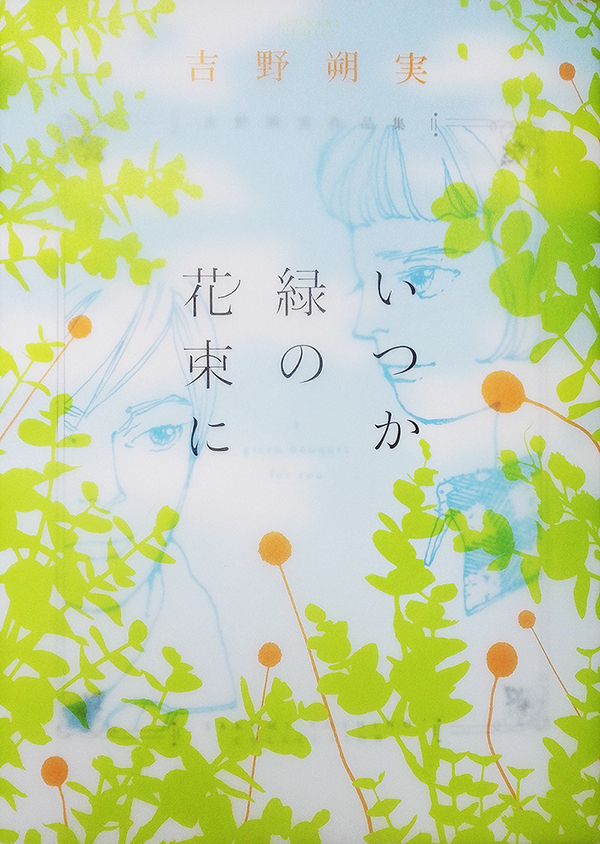 Today marks the first anniversary of mangaka Yoshino Sakumi’s death on April 20, 2016. The sad news came as a tremendous shock to many of us as it was so sudden and unexpected. Yoshino Sakumi, born in 1959, debuted in 1980 in Shueisha’s now folded Bouquet magazine and made a name for herself with works featuring memorably quirky characters, often twins, just as often going through a serious identity crisis, and exploring the depths of the human mind and soul. ShÅnen wa kÅya wo mezasu (1985-1987), Juliette no tamago (1988-1989) or the long-running period, published in Shogakukan’s defunct seinen magazine IKKI from 2004 to 2014, are among her most beloved and well-known works. Yoshino was also a respected film and literary critic and essayist.
Today marks the first anniversary of mangaka Yoshino Sakumi’s death on April 20, 2016. The sad news came as a tremendous shock to many of us as it was so sudden and unexpected. Yoshino Sakumi, born in 1959, debuted in 1980 in Shueisha’s now folded Bouquet magazine and made a name for herself with works featuring memorably quirky characters, often twins, just as often going through a serious identity crisis, and exploring the depths of the human mind and soul. ShÅnen wa kÅya wo mezasu (1985-1987), Juliette no tamago (1988-1989) or the long-running period, published in Shogakukan’s defunct seinen magazine IKKI from 2004 to 2014, are among her most beloved and well-known works. Yoshino was also a respected film and literary critic and essayist. 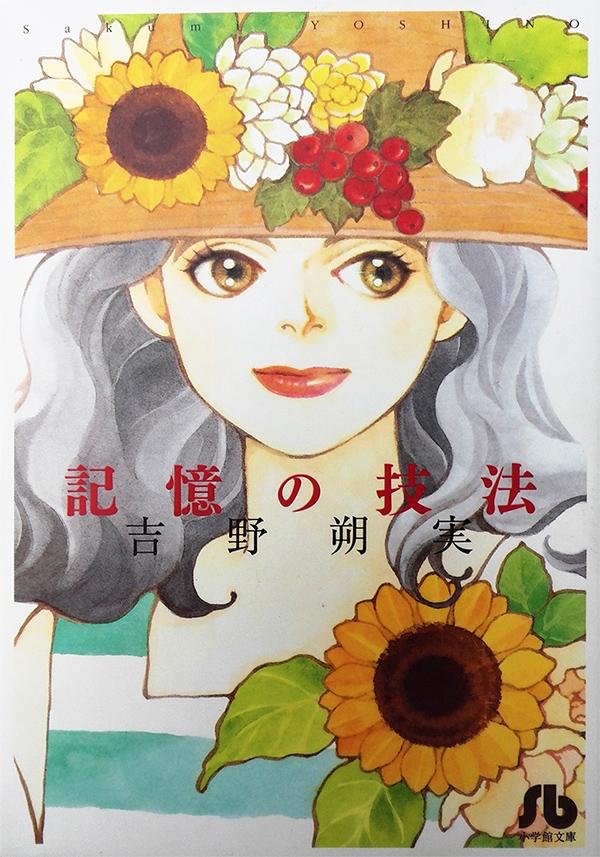 The works of her late period are closely linked with Shogakukan’s Gekkan flowers magazine. One of her strongest manga, the psychological thriller and human drama Kioku no gihÅ (highly recommended if you want to buy one single bunko volume to sample the authors work, be prepared for some emotional shocks though!), was published in the very first issue of the magazine in 2002 and a colour illustration for it was used on the cover. Through the first and second decade of the new millenium, she kept coming back to the magazine for more one-shots and visually intriguing two-tone comics.
The works of her late period are closely linked with Shogakukan’s Gekkan flowers magazine. One of her strongest manga, the psychological thriller and human drama Kioku no gihÅ (highly recommended if you want to buy one single bunko volume to sample the authors work, be prepared for some emotional shocks though!), was published in the very first issue of the magazine in 2002 and a colour illustration for it was used on the cover. Through the first and second decade of the new millenium, she kept coming back to the magazine for more one-shots and visually intriguing two-tone comics.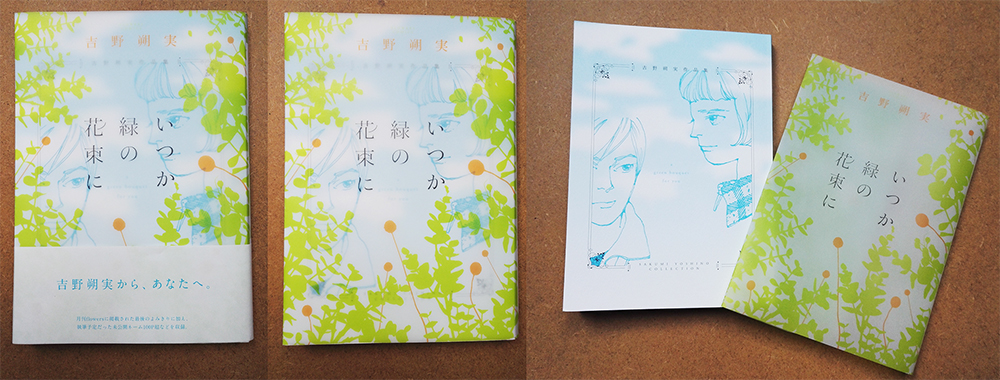
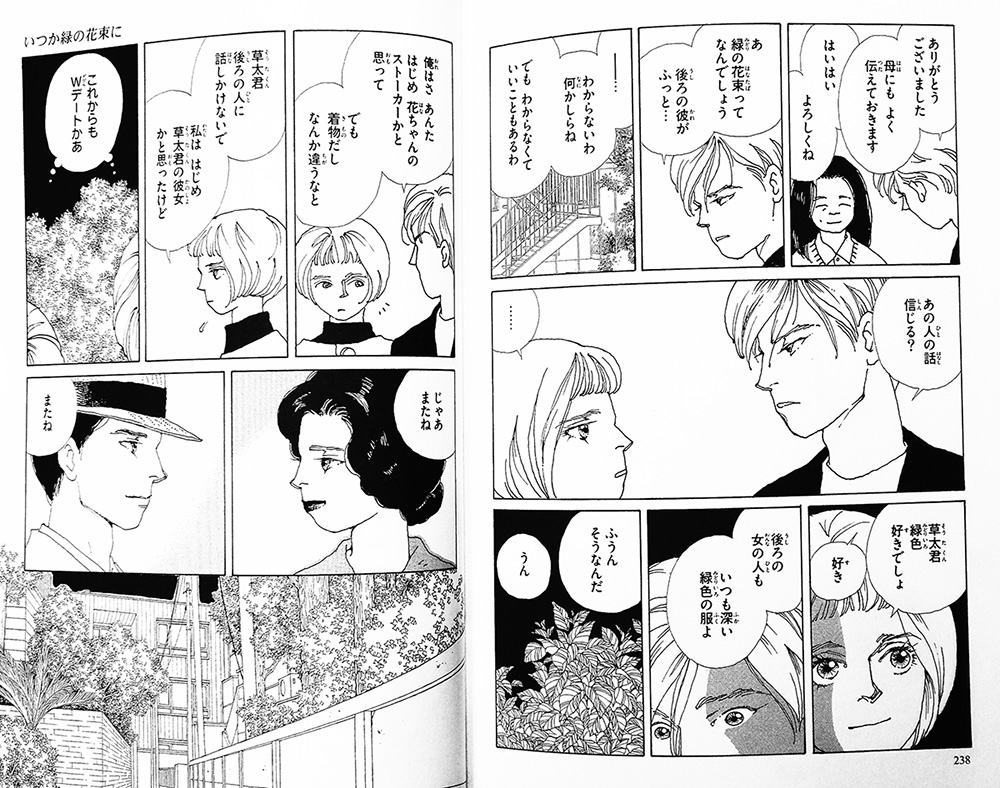
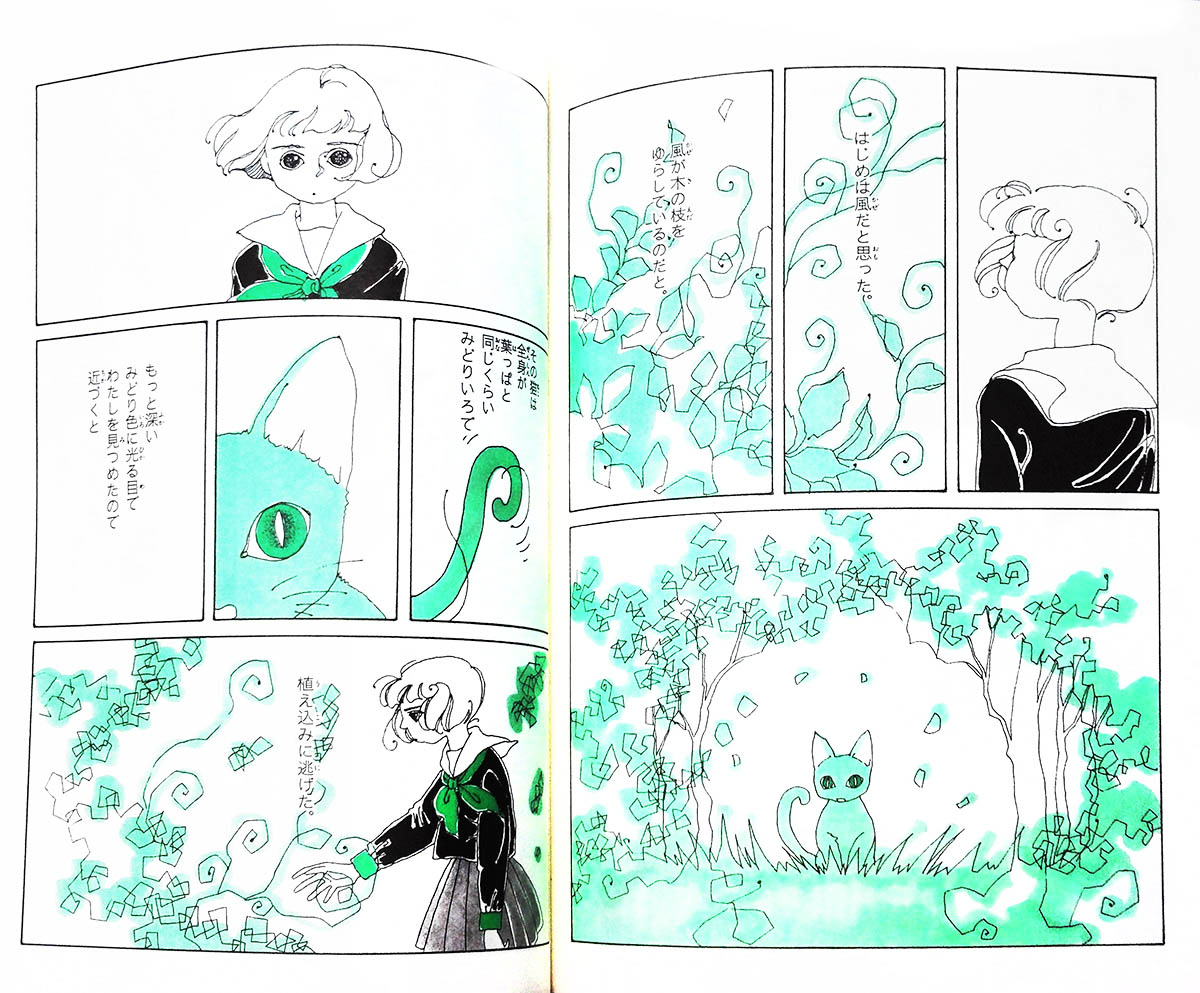
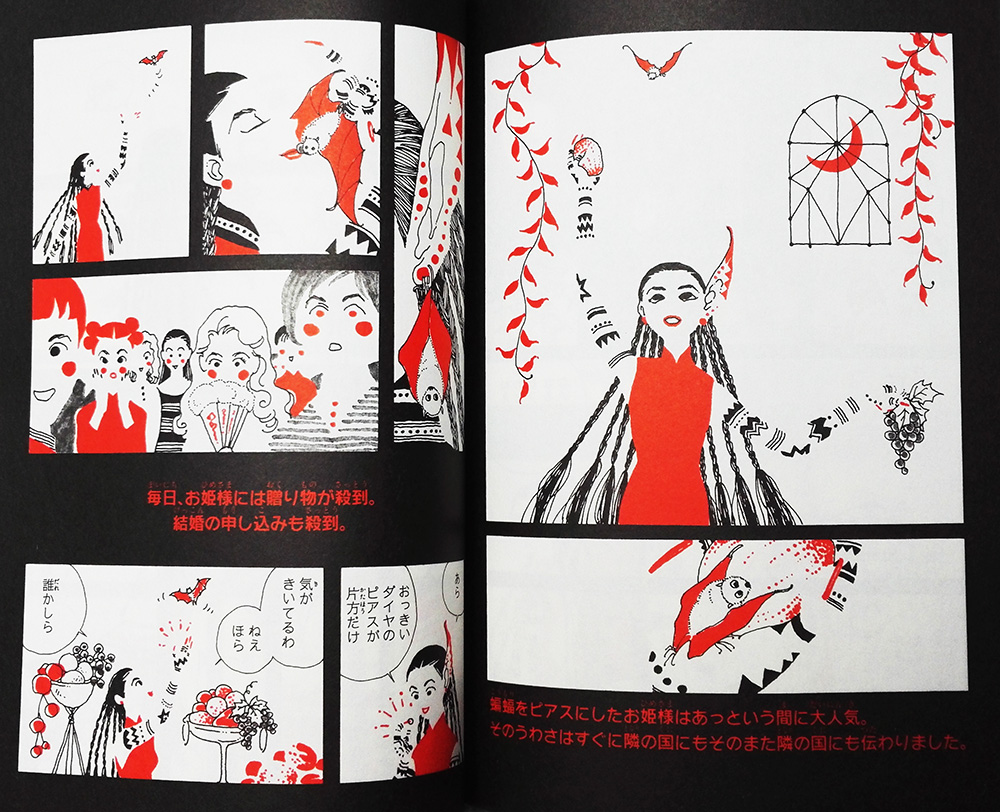
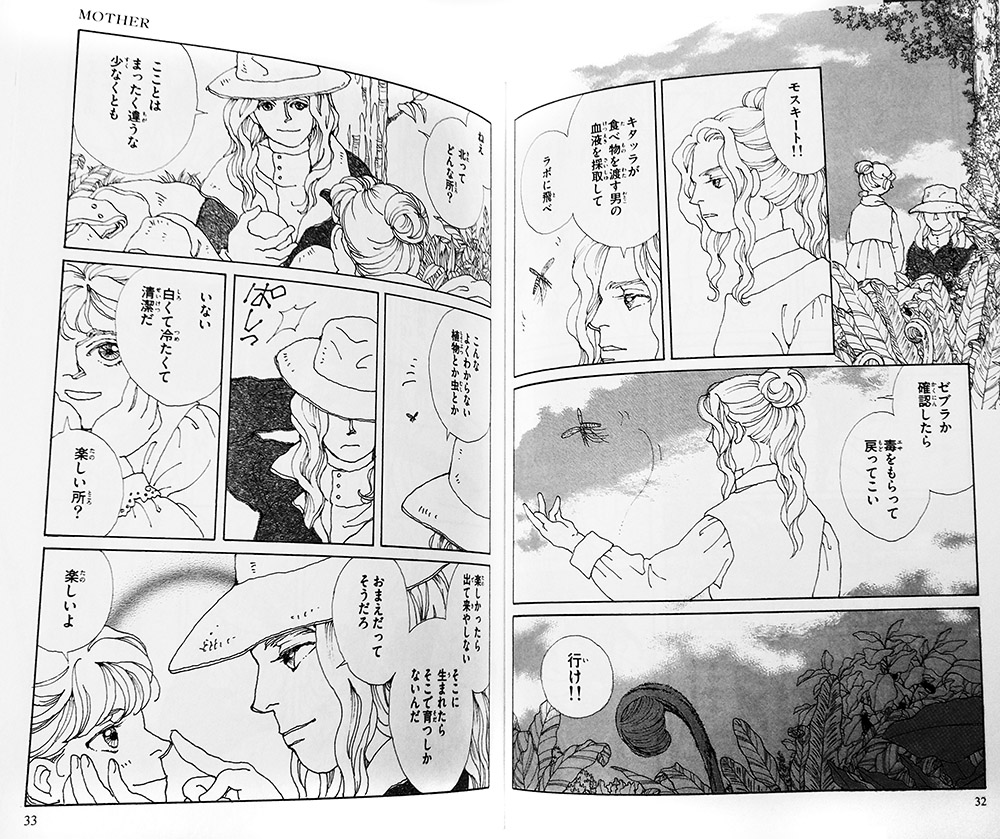
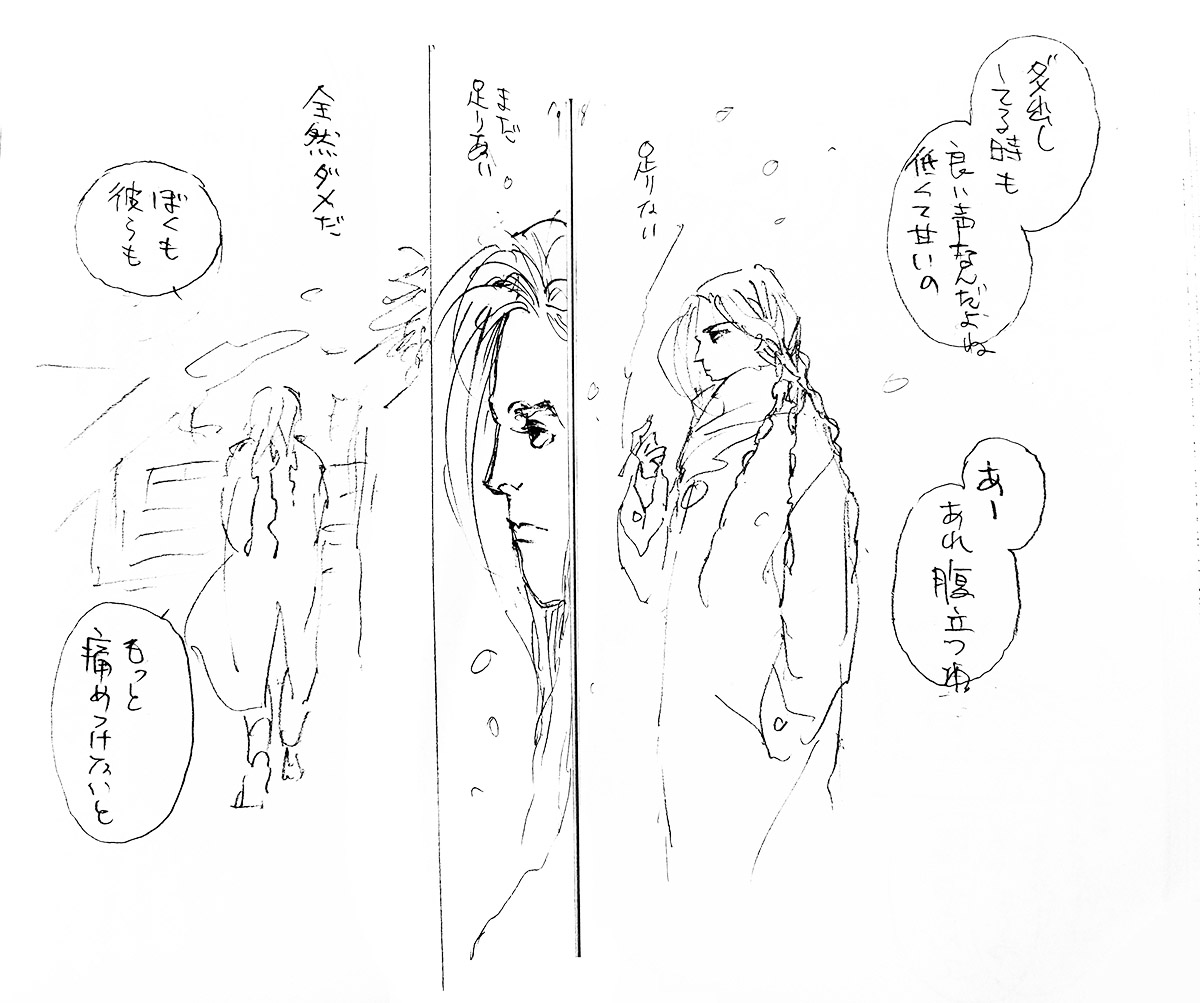
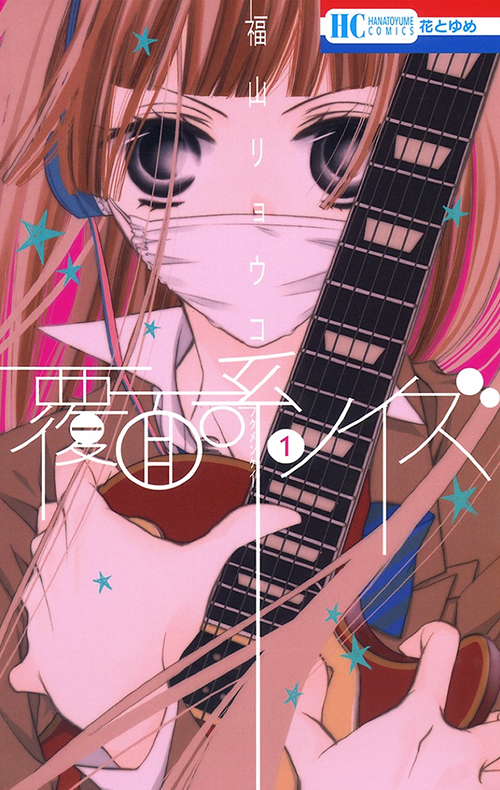 As a young girl, Arisugawa Nino used to sing with Yuzu, the boy living in the house next to her family’s, which gave her strength and comfort when her parents were fighting. Yuzu moves away one day but Nino is lucky enough to become friends with Yuzu, a boy who composes songs for Nino until he too moves away. Nino is determined to find both Nino and Yuzu again through her singing voice which might lead them back to her. Now, in senior high, Nino is surprised to meet Yuzu who is secretly in the popular newcomer band in NO hurry to shout (Inohari) whose members are wearing bandages and eye-patches to hide their identities. Yuzu asks Nino to join them as their lead singer Alice and this inspires him to write new songs for the band. Nino doesn’t yet know that none other than Momo is now a) a famous pop composer, b) the bassist of a band called SILENT BLACK KITTY (Kuroneko) criticized for being an Inohari copy band plus c) a student in the school Nino and Yuzu attend. When they finally meet again, Momo rejects Nino as he secretly feels ashamed he sold his songs originally written for Nino to other pop singers while Yuzu also has his eyes set on Nino, his Alice – another one-sided love in this triangle that fuels the creative energy of these three young people.
As a young girl, Arisugawa Nino used to sing with Yuzu, the boy living in the house next to her family’s, which gave her strength and comfort when her parents were fighting. Yuzu moves away one day but Nino is lucky enough to become friends with Yuzu, a boy who composes songs for Nino until he too moves away. Nino is determined to find both Nino and Yuzu again through her singing voice which might lead them back to her. Now, in senior high, Nino is surprised to meet Yuzu who is secretly in the popular newcomer band in NO hurry to shout (Inohari) whose members are wearing bandages and eye-patches to hide their identities. Yuzu asks Nino to join them as their lead singer Alice and this inspires him to write new songs for the band. Nino doesn’t yet know that none other than Momo is now a) a famous pop composer, b) the bassist of a band called SILENT BLACK KITTY (Kuroneko) criticized for being an Inohari copy band plus c) a student in the school Nino and Yuzu attend. When they finally meet again, Momo rejects Nino as he secretly feels ashamed he sold his songs originally written for Nino to other pop singers while Yuzu also has his eyes set on Nino, his Alice – another one-sided love in this triangle that fuels the creative energy of these three young people.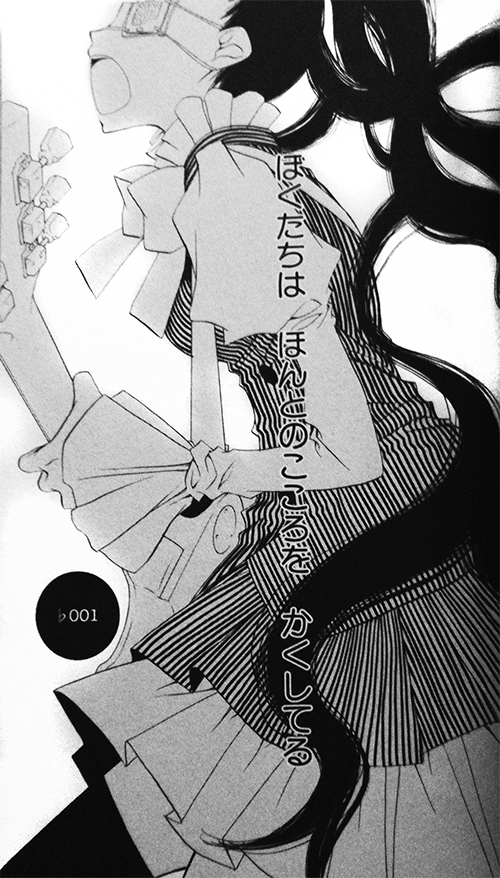 This is the premise of Fukuyama RyÅko’s manga Fukumenkei Noise (Anonymous Noise) which has been running in Hakusensha’s Hana to Yume magazine since 2013, with 12 comic volumes published so far. This is already quite a long series with probably much more material to follow but it doesn’t take more than the first and a little bit of the second volume for the foundation of the plot to be established. One copyline repeatedly used for the series is “Kokoro kakushita kataomoi melody” which roughly translates to “The melody of unrequited love hiding our try feelings” and cleverly refers to Fukumenkei Noise‘s two main elements: romance and music. Inohari’s and Kuroneko’s respective roads to success and their rivalry always run parallel to the main love triangle with all those feelings of attraction and the need for distance it entails plus the side stories also filled with stories of unrequited love. We have Nino who is in love with Momo, Momo who won’t allow himself to return Nino’s feelings, Yuzu who has more than just feelings of inspiration for Nino, Miou who has a crush on Yuzu, Haruyoshi who wants Miou to forget about Yuzu, Kuro who is in love with his older brother’s wife… Yes, we’re in for quite a bit of heartache.
This is the premise of Fukuyama RyÅko’s manga Fukumenkei Noise (Anonymous Noise) which has been running in Hakusensha’s Hana to Yume magazine since 2013, with 12 comic volumes published so far. This is already quite a long series with probably much more material to follow but it doesn’t take more than the first and a little bit of the second volume for the foundation of the plot to be established. One copyline repeatedly used for the series is “Kokoro kakushita kataomoi melody” which roughly translates to “The melody of unrequited love hiding our try feelings” and cleverly refers to Fukumenkei Noise‘s two main elements: romance and music. Inohari’s and Kuroneko’s respective roads to success and their rivalry always run parallel to the main love triangle with all those feelings of attraction and the need for distance it entails plus the side stories also filled with stories of unrequited love. We have Nino who is in love with Momo, Momo who won’t allow himself to return Nino’s feelings, Yuzu who has more than just feelings of inspiration for Nino, Miou who has a crush on Yuzu, Haruyoshi who wants Miou to forget about Yuzu, Kuro who is in love with his older brother’s wife… Yes, we’re in for quite a bit of heartache.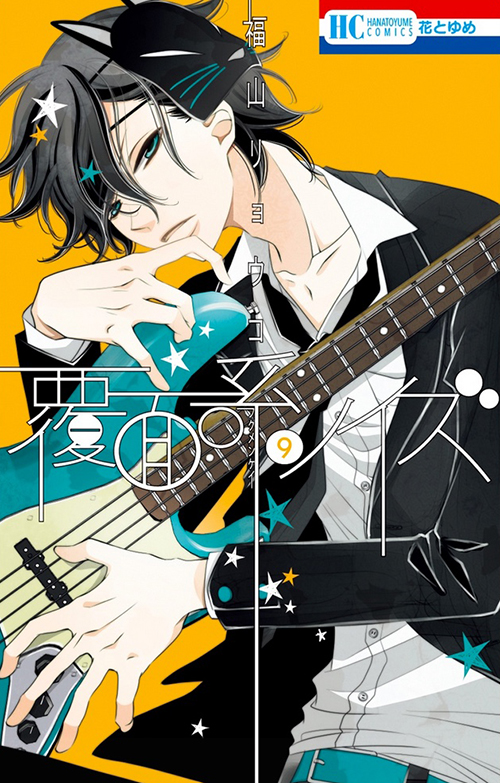 But the backbone of the series is definitely the music aspect. Nino’s journey toward becoming a stronger singer who tries to reach out for her audience and the other main characters’ developments as artists give the series an interesting focus beyond the romance aspect. The dynamics within Inohari make the manga fun and entertaining, as Nino/Alice, Yuzu, Miou, Haruyoshi and Kuro have a lively (but also emotional and complicated) chemistry among themselves. Their rise within the music scene is maybe not completely realistic but it doesn’t leave out the hard work, planning and practice it takes to compose, record and perform hit singles and albums. And it’s that last aspect, the live performances so powerfully put into images in the manga that lend Fukumenkei Noise an almost irresistable sense of pressing urgency and youthful energy. Fukuyama RyÅko relies a lot on her own research and photos she’s taking at concerts and festivals for her visual portrayal of Inohari as a live band. And it definitely pays off because as a reader you do feel the adrenaline rush both of the band and the audience – which is so important because as a manga, the series can’t rely on the key ingredient of the story, the music itself!
But the backbone of the series is definitely the music aspect. Nino’s journey toward becoming a stronger singer who tries to reach out for her audience and the other main characters’ developments as artists give the series an interesting focus beyond the romance aspect. The dynamics within Inohari make the manga fun and entertaining, as Nino/Alice, Yuzu, Miou, Haruyoshi and Kuro have a lively (but also emotional and complicated) chemistry among themselves. Their rise within the music scene is maybe not completely realistic but it doesn’t leave out the hard work, planning and practice it takes to compose, record and perform hit singles and albums. And it’s that last aspect, the live performances so powerfully put into images in the manga that lend Fukumenkei Noise an almost irresistable sense of pressing urgency and youthful energy. Fukuyama RyÅko relies a lot on her own research and photos she’s taking at concerts and festivals for her visual portrayal of Inohari as a live band. And it definitely pays off because as a reader you do feel the adrenaline rush both of the band and the audience – which is so important because as a manga, the series can’t rely on the key ingredient of the story, the music itself!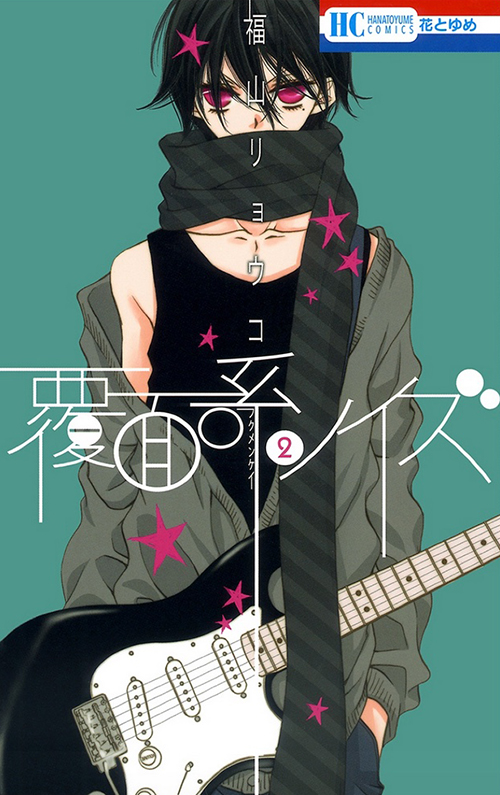 A very minor flaw I’ve noticed is the series is already quite long and there are parts where the plot stalls a little and doesn’t move along as quickly as you’d like. For example, the urgency and speed of the first two volumes are soon replaced by somewhat repetitive scenes of Nino/Alice running amok on stage with her voice, Nino running after Momo has heard her voice while Yuzu’s looking sadly after her, determined to make her voice his. We often get poetic monologues, with sometimes Nino’s and Yuzu’s thoughts running in synchronicity throughout a scene. This can be both a little overwhelming and confusing from time to time, but in the original Japanese version you can at least formally tell their lines apart as Yuzu’s are displayed in hiragana. At the same time, this adds to the sense of chaos and sheer NOISE in the manga which helps build up a very unique atmosphere. And ultimately, the slower chapters serve to build up tension until a change finally happens, for example when Nino overcomes her slump after the band’s first festival appearance and realizes she needs to become a better vocalist by training hard and trying to reach out to the audience in front of her.
A very minor flaw I’ve noticed is the series is already quite long and there are parts where the plot stalls a little and doesn’t move along as quickly as you’d like. For example, the urgency and speed of the first two volumes are soon replaced by somewhat repetitive scenes of Nino/Alice running amok on stage with her voice, Nino running after Momo has heard her voice while Yuzu’s looking sadly after her, determined to make her voice his. We often get poetic monologues, with sometimes Nino’s and Yuzu’s thoughts running in synchronicity throughout a scene. This can be both a little overwhelming and confusing from time to time, but in the original Japanese version you can at least formally tell their lines apart as Yuzu’s are displayed in hiragana. At the same time, this adds to the sense of chaos and sheer NOISE in the manga which helps build up a very unique atmosphere. And ultimately, the slower chapters serve to build up tension until a change finally happens, for example when Nino overcomes her slump after the band’s first festival appearance and realizes she needs to become a better vocalist by training hard and trying to reach out to the audience in front of her.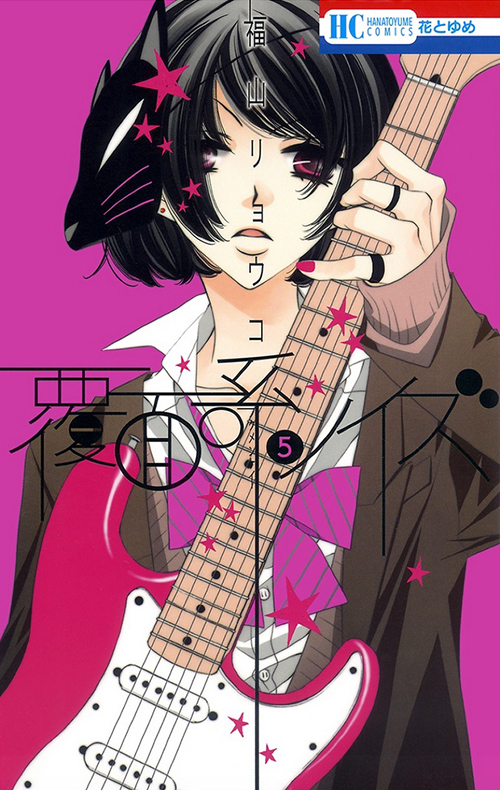 Momo and Yuzu both have complicated relationships with their mothers which is something we only realize bit by bit through hints dropped in short dialogues and backflashes. There are some really cute childhood scenes, especially for Yuzu and Nino. The scenes of their meetings at the beautiful shore of Yuigahama, when they’re kids and then later after they’ve met again, are really powerful. But there are comic elements too, with the constant joke being Yuzu and his omnipresent carton of milk because he’s quite vertically challenged and would love to be taller. We get slapstick elements, some fighting and bickering among the members, some idiosyncratic patterns of behaviour and speech from certain members, like Haruyoshi who refers to himself as atashi, a pronoun reserved for females, and uses a lot of female speech patterns because he grew up with 6 sisters :) And one thing I love is the portrayal of the friendship between the two Inohari girls, Nino and Miou, despite the fact that it’s Nino who gets all that attention from Miou’s crush Yuzu. (I shall forever worship at the shrine dedicated to Miou while everyone else is deciding whether they’re Team Momo or Team Yuzu ;) There’s also a cast of more or less charming minor characters, the Kuroneko band members, other artists and models they work with, the managers and producers, journalists and some fans who serve to shed light on the bands’ stories from their respective perspective, but they always remain somewhat sidelined in the presence of the triangle Nino-Momo-Yuzu.
Momo and Yuzu both have complicated relationships with their mothers which is something we only realize bit by bit through hints dropped in short dialogues and backflashes. There are some really cute childhood scenes, especially for Yuzu and Nino. The scenes of their meetings at the beautiful shore of Yuigahama, when they’re kids and then later after they’ve met again, are really powerful. But there are comic elements too, with the constant joke being Yuzu and his omnipresent carton of milk because he’s quite vertically challenged and would love to be taller. We get slapstick elements, some fighting and bickering among the members, some idiosyncratic patterns of behaviour and speech from certain members, like Haruyoshi who refers to himself as atashi, a pronoun reserved for females, and uses a lot of female speech patterns because he grew up with 6 sisters :) And one thing I love is the portrayal of the friendship between the two Inohari girls, Nino and Miou, despite the fact that it’s Nino who gets all that attention from Miou’s crush Yuzu. (I shall forever worship at the shrine dedicated to Miou while everyone else is deciding whether they’re Team Momo or Team Yuzu ;) There’s also a cast of more or less charming minor characters, the Kuroneko band members, other artists and models they work with, the managers and producers, journalists and some fans who serve to shed light on the bands’ stories from their respective perspective, but they always remain somewhat sidelined in the presence of the triangle Nino-Momo-Yuzu.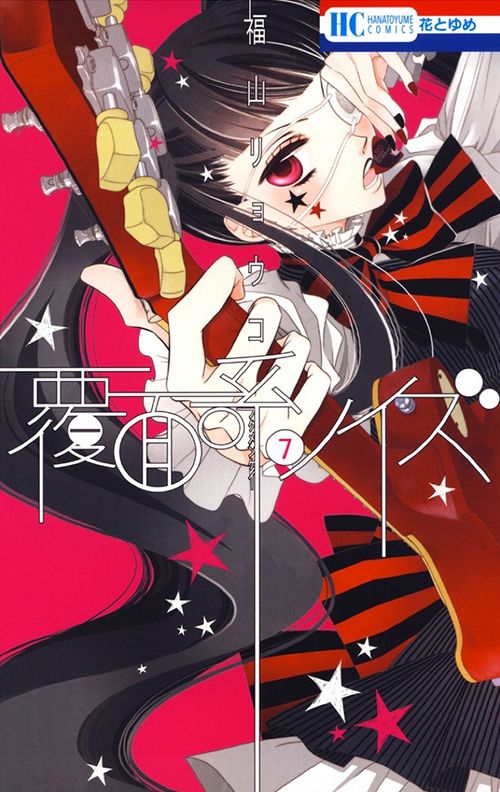 Fukumenkei refers to the fact that both Inohari and Kuroneko use masks, eye-patches and bandages to hide their true identities; this gives them very unique looks, one might say they look slightly visual-kei, with a gothic lolita-inspired Alice. Fukuyama’s forte as a mangaka are definitely her illustrations, especially the ones in color. (In that respect, it’s a real loss for the charms of the series that most of the color illustrations are printed just black and white in the tankÅbon versions and can only be fully enjoyed by magazine readers until an artbook is released.) These images match the aesthetics used for ‘real’ albums covers, concert posters, ads and magazine spreads perfectly, giving readers the chance to follow Inohari almost like a band that exists in real life. This experience will now become only stronger with
Fukumenkei refers to the fact that both Inohari and Kuroneko use masks, eye-patches and bandages to hide their true identities; this gives them very unique looks, one might say they look slightly visual-kei, with a gothic lolita-inspired Alice. Fukuyama’s forte as a mangaka are definitely her illustrations, especially the ones in color. (In that respect, it’s a real loss for the charms of the series that most of the color illustrations are printed just black and white in the tankÅbon versions and can only be fully enjoyed by magazine readers until an artbook is released.) These images match the aesthetics used for ‘real’ albums covers, concert posters, ads and magazine spreads perfectly, giving readers the chance to follow Inohari almost like a band that exists in real life. This experience will now become only stronger with 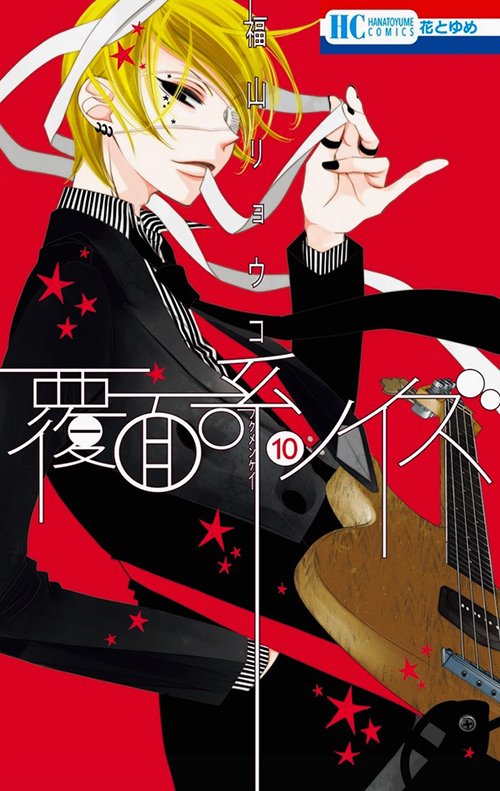 Fukumenkei Noise has the ability to captivate a wide readership, both female and male, despite being a shÅjo manga title. It might be similar to another HanaYume series in that respect, i.e. Takaya Natsuki’s Fruits Basket which was also able to reach even more people after it received its anime adaptation and it remains to be seen if Fukumenkei Noise can manage the same. And you cannot help but feel that Fukumenkei Noise also pays homage to the cult classic, the iconic, the one and only music and romance manga for girls by Yazawa Ai – the unfinished NANA! With the genre and a heroine called Nino which isn’t all that far from Nana, the shared name of the two heroines of Yazawa’s hit series, Fukumenkei Noise has been predestined for comparisons with the former. And it is definitely not wrong to call Fukumenkei Noise a NANA for middle schoolers, targeting mainly 13 or 14-year old girls, unlike NANA with its slightly older fan demographic. Fukumenkei Noise is fun, energetic and eye-catching but it sometimes lacks the depth and emotional scope of NANA as it never looks for too long into the abyss of desperation the way Yazawa’s unfinished masterpiece does.
Fukumenkei Noise has the ability to captivate a wide readership, both female and male, despite being a shÅjo manga title. It might be similar to another HanaYume series in that respect, i.e. Takaya Natsuki’s Fruits Basket which was also able to reach even more people after it received its anime adaptation and it remains to be seen if Fukumenkei Noise can manage the same. And you cannot help but feel that Fukumenkei Noise also pays homage to the cult classic, the iconic, the one and only music and romance manga for girls by Yazawa Ai – the unfinished NANA! With the genre and a heroine called Nino which isn’t all that far from Nana, the shared name of the two heroines of Yazawa’s hit series, Fukumenkei Noise has been predestined for comparisons with the former. And it is definitely not wrong to call Fukumenkei Noise a NANA for middle schoolers, targeting mainly 13 or 14-year old girls, unlike NANA with its slightly older fan demographic. Fukumenkei Noise is fun, energetic and eye-catching but it sometimes lacks the depth and emotional scope of NANA as it never looks for too long into the abyss of desperation the way Yazawa’s unfinished masterpiece does.